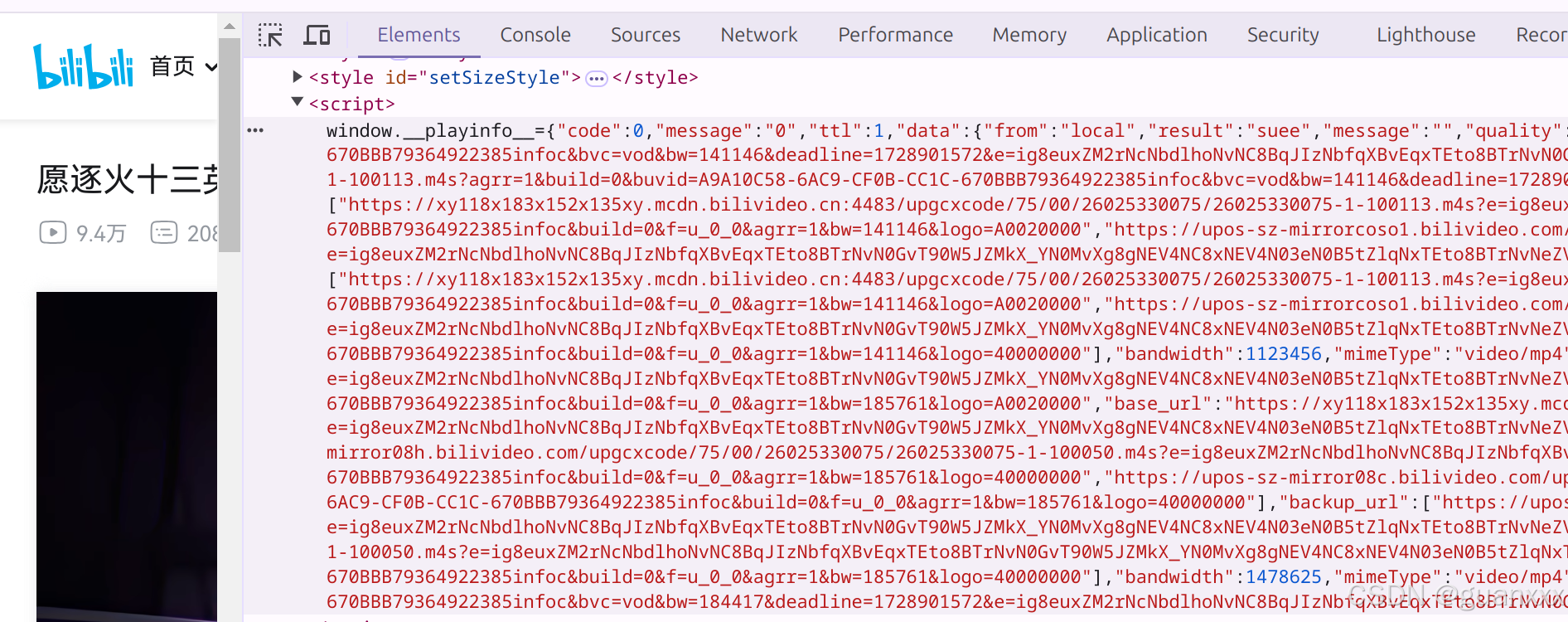本文想要达成的目标为:运行 python 代码之后,在终端输入视频链接,可自动下载高清 1080P 视频并保存到相应文件夹。
具体可分为两大步:首先,使用浏览器开发者工具 F12 获取请求链接相关信息(根据 api 接口下载?加密参数信息?是从 html 文件获取到具体的链接?链接在 html 文件中位置?);然后,确定使用的 python 库,并写出代码。
最后代码运行结果如图所示:


1. 确定请求链接信息
打开一个视频,对整个过程中的请求进行分析,确定视频链接和音频链接;(下图 1)
首先从 html 源码进行查找,找到了对应的音视频链接;(下图 2)
经过分析,可使用 beautifulsoup 库定位元素位置,标题定位为 bs.find('div', id='viewbox_report').find('div', class_='video-info-title').div.h1.string,视频链接定位为 bs.head.find_all('script', limit=4)[-1].string.lstrip('window.__playinfo__=')['data']['dash']['video'][2]['baseUrl'],音频链接定位为 bs.head.find_all('script', limit=4)[-1].string.lstrip('window.__playinfo__=')['data']['dash']['audio'][0]['baseUrl']。


2. 使用 requests 库下载音视频文件
2.1. 获取 html 源代码
可使用以下函数获取 html 文档:(注:经测试,下载 1080p 视频需要在请求头中加入 登陆帐号cookie)
def _request_html(url: str): '''获取 html 文档源代码并返回''' response = get(url, headers={}) response.encoding = response.apparent_encoding return response.text2.2. 下载音视频文件并保存
然后,可根据上一步得到的链接位置,通过 bs 库对 html 文档进行解析,得到所需的 视频标题、视频链接、音频链接,使用 requests 库发送请求下载文件,并存储到本地。
注:因为音视频分离,所以可使用 aiohttp 进行异步下载,稍微提高效率;
注:为美观以及方便查看进度,可使用 rich 库添加进度条;
注:视频文件有时可能比较大,因此可使用流数据分块下载方式进行;
以下代码为提取所需信息代码,可进行参考:(注:首选视频链接有时会失效,因此需提取备用链接)
@staticmethoddef _extract_title_url(html: str): bs = BeautifulSoup(html, 'lxml') # 提取视频标题,并去除非法字符 title = bs.find('div', id='viewbox_report').find('div', class_='video-info-title').div.h1.string for i in {'/', '\\', '|', '<', '>', '\'', '\"', '?', ':', '*', '\x00'}: title = title.replace(i, ' ') # 提取音视频链接 info = bs.head.find_all('script', limit=4)[-1].string.lstrip('window.__playinfo__=') info_dict = loads(info) video_urls = ( info_dict['data']['dash']['video'][2]['baseUrl'], info_dict['data']['dash']['video'][2]['backupUrl'][0] ) audio_urls = ( info_dict['data']['dash']['audio'][0]['baseUrl'], info_dict['data']['dash']['audio'][0]['backupUrl'][0], ) return (title, video_urls, audio_urls)3. 使用 ffmpeg 合并音视频
可使用 ffmpeg 进行音视频的合并,合并完毕后删除音视频文件。
注:使用 pip 安装时命令为:pip install ffmpeg-python
注:可使用 rich 库添加进度条
代码如下,可参考:
def _merge(video_path: str, audio_path: str, filepath: str): '''合并音视频''' with _progress_object_merge() as progress: progress.add_task('正在合并音视频', total=None) input_video = ffmpeg_input(video_path) input_audio = ffmpeg_input(audio_path) output = ffmpeg_output(input_video, input_audio, filepath, vcodec='copy', acodec='aac') ffmpeg_run(output, quiet=True) print(f'{filepath} 合并完成') remove(video_path) remove(audio_path)def _progress_object_merge(): '''合并音视频的进度条设置''' return Progress( TextColumn('[progress.description]{task.description}', style=CYAN, justify='left'), '•', BarColumn(bar_width=20), '•', TimeElapsedColumn(), transient=True, )